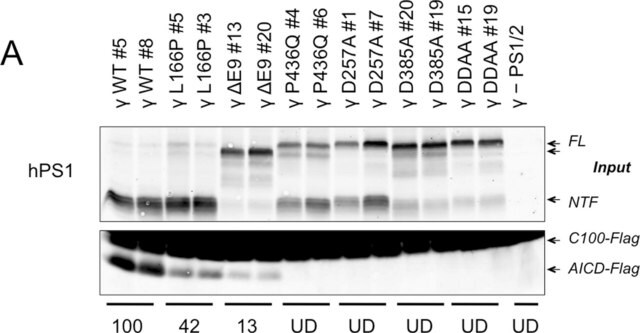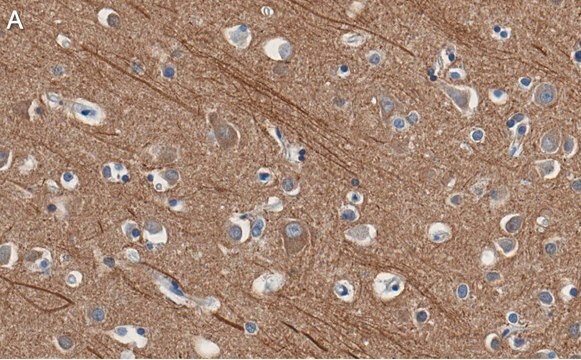MAB5232
Anti-Presenilin-1 Antibody, loop, a.a. 263-378, CT, clone PS1-loop
ascites fluid, clone PS1-loop, Chemicon®
Synonym(e):
Anti-ACNINV3, Anti-AD3, Anti-FAD, Anti-PS1, Anti-S182
About This Item
Empfohlene Produkte
Biologische Quelle
mouse
Antikörperform
ascites fluid
Antikörper-Produkttyp
primary antibodies
Klon
PS1-loop, monoclonal
Speziesreaktivität
rat, primate, mouse, human
Hersteller/Markenname
Chemicon®
Methode(n)
immunocytochemistry: suitable
immunohistochemistry: suitable (paraffin)
immunoprecipitation (IP): suitable
western blot: suitable
Isotyp
IgG1
NCBI-Hinterlegungsnummer
UniProt-Hinterlegungsnummer
Versandbedingung
dry ice
Posttranslationale Modifikation Target
unmodified
Angaben zum Gen
human ... PSEN1(5663)
Allgemeine Beschreibung
Spezifität
Immunogen
Anwendung
Neurowissenschaft
Neurodegenerative Krankheiten
A previous lot of this antibody was used in IC.Acetone or methanol fixed cells; or lightly fixed 2.5-3% PFA (5-10′ RT).
Immunohistochemistry:
A previous lot was used on 3% paraformaldehyde fixed tissue. Works on paraffin embedded tissue sections if fixed with PLP, acetone or other light fixations; 10% formalin fixation is untested.
Immunoprecipitation:
A previous lot of this antibody was used in IP.
Western blot:
Recognizes a protein of approximately 18-20 kD, and occasionally there is a doublet (the top band of which is phosphorylated).
Optimal working dilutions must be determined by the end user
Qualität
Western Blot Analysis:
1:500 dilution of this lot detected PRESENILIN-1 on 10 μg of PC12 lysates.
Zielbeschreibung
Physikalische Form
Lagerung und Haltbarkeit
Handling Recommendations: Upon receipt, and prior to removing the cap, centrifuge the vial and gently mix the solution. Aliquot into microcentrifuge tubes and store at -20°C. Avoid repeated freeze/thaw cycles, which may damage IgG and affect product performance.
Hinweis zur Analyse
Brain tissue
Sonstige Hinweise
Rechtliche Hinweise
Haftungsausschluss
Sie haben nicht das passende Produkt gefunden?
Probieren Sie unser Produkt-Auswahlhilfe. aus.
Empfehlung
Lagerklassenschlüssel
10 - Combustible liquids
WGK
WGK 1
Flammpunkt (°F)
Not applicable
Flammpunkt (°C)
Not applicable
Analysenzertifikate (COA)
Suchen Sie nach Analysenzertifikate (COA), indem Sie die Lot-/Chargennummer des Produkts eingeben. Lot- und Chargennummern sind auf dem Produktetikett hinter den Wörtern ‘Lot’ oder ‘Batch’ (Lot oder Charge) zu finden.
Besitzen Sie dieses Produkt bereits?
In der Dokumentenbibliothek finden Sie die Dokumentation zu den Produkten, die Sie kürzlich erworben haben.
Unser Team von Wissenschaftlern verfügt über Erfahrung in allen Forschungsbereichen einschließlich Life Science, Materialwissenschaften, chemischer Synthese, Chromatographie, Analytik und vielen mehr..
Setzen Sie sich mit dem technischen Dienst in Verbindung.








